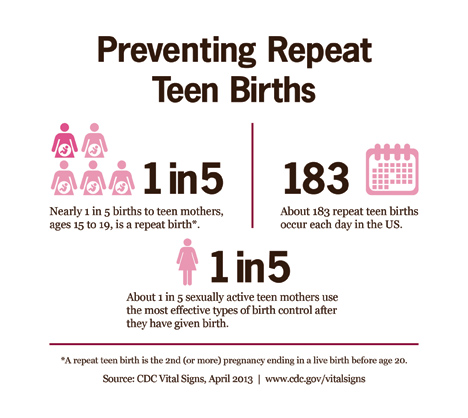 Join La Costa Latina
on
Facebook
Join La Costa Latina
on
Facebook


Advertise with us
(850) 494-7899
news@latinomediainc.com
|
 |
Advertise with us |
|---|
Casi 20 por ciento de los embarazos en adolescentes son repetidos: Embarazos repetidos pueden ser prevenidos
|
Nearly 20 percent of teen births are repeat births: Repeat births can be prevented  Although teen births have fallen over the past 20 years, nearly one in five teen births is a repeat birth, according to a Vital Signs report from the Centers for Disease Control and Prevention. More than 365,000 teens, ages 15-19 years, gave birth in 2010, and almost 67,000 (18.3 percent) of those were repeat births. A repeat birth is a second (or more) pregnancy resulting in a live birth before the age of 20. Almost any pregnancy during the teen years can change the lives and futures of the mother, child and family. Infants born as a result of a repeat pregnancy are also more likely to be born too soon (premature) and born too small (at low birth weight). “Teen birth rates in the United States have declined to a record low, which is good news,” said CDC Director Tom Frieden, M.D., M.P.H. “But rates are still far too high. Repeat births can negatively impact the mother’s education and job opportunities as well as the health of the next generation. Teens, parents, health care providers, and others need to do much more to reduce unintended pregnancies.” Data from CDC’s National Vital Statistics System show that repeat teen births in the United States decreased by more than 6 percent between 2007 and 2010. Despite this decline, the number of repeat births remains high and there are substantial racial/ethnic and geographic differences. Repeat teen births were highest among American Indian/Alaska Natives (21.6 percent), Hispanics (20.9 percent), and non-Hispanic blacks (20.4 percent), and lowest among non-Hispanic whites (14.8 percent). There were also geographic disparities. Repeat teen births ranged from 22 percent in Texas to 10 percent in New Hampshire. Data show that although nearly 91 percent of teen mothers who were sexually active used some form of contraception in the postpartum period, only 22 percent used contraceptives considered to be “most effective” (that is, where the risk is less than one pregnancy per 100 users in a year). To prevent repeat teen births health care providers, parents, guardians, and caregivers can talk to both male and female teens about avoiding pregnancy by not having sex and can discuss with sexually active teens the most effective types of birth control to prevent repeat teen pregnancy. For more information about teen pregnancy, visit CDC’s Web site at http://www.cdc.gov/teenpregnancy. |